ITALY - MARGHERITA ERRANTE
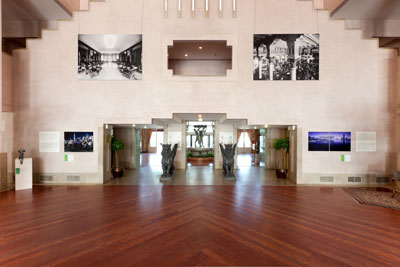
Men looking out onto a new era, at the window of the future which advances, wiping out a cumbersome past. Individuals who become spectators before modern society, which proceeds in great haste. Human beings numbed by the stories told by unpublished actors about a China that is starting again from Year Zero, beginning from megalithic architectural works, contemporary pyramids under which the old world is silently dying. Speed is sweeping away thousands of people who live on a continent where there is no more room for leisurely bicycle rides, but only highways created for fast cars and men who have no more time for themselves. So farm labours put on strange workers’ overalls, emigrating to seek their fortune in the virgin cities that the whole world looks on with fear, with the same sense of bewilderment that afflicts a people whose identity has been wrenched away, wiped out by heavy structures of glass, iron and cement, now the only futuristic forms in which the Chinese can and want to recognize themselves with pride. The world has stopped here, and will start again from zero.
Text by Jessica Anais Savoia
ITALY - CRASH TOYS (KOJI YOSHIDA, DARIO TIRONI)
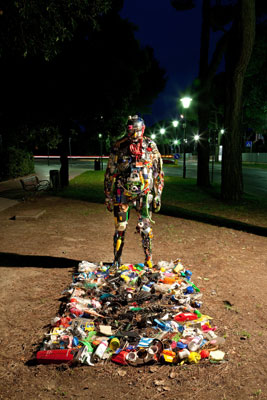
In Things by Crash Toys (Koji Yoshida and Dario Tironi), objects, pieces of material and rubbish have occupied so much of man’s life that they have stolen his structure and assumed his likeness. A man and a woman sit by a cradle, but the sweetness and protection expressed by the family group are threatened by a noticeable sense of instability and precariousness communicated by their bodies, pure agglomerations of things. Pieces in precarious equilibrium, even though they are perfectly positioned one next to the other. In a kind of visual antithesis, Crash Toys express considerations about man and nature, which seems to be enclosed in a state of evolution-involution. These sculptures are assembled portraits of individuals with details of the faces, just as in the works of Arcimboldo, where the objects metaphorically connected to the subject, because he makes use of them in his life, de-sublimate the portrait. The volumes of waste material enable us to read the anatomic structure of the bodies, but at the same time they seem to invalidate deeper structures of the human being, suggesting an obligatory passage to the artificial world in which the residue of the objects originated. Environmental pollution expands its boundaries, goes beyond its physical limits and, like a virus, attacks our synapses, our mental systems. Values too, transmitted by the family and by experience, are affected by pollution and seem to be more and more precarious, in a constant search for the right piece to make up what we are each day.
Text by Barbara Melato
ITALY - GAETANO K. BODANZA
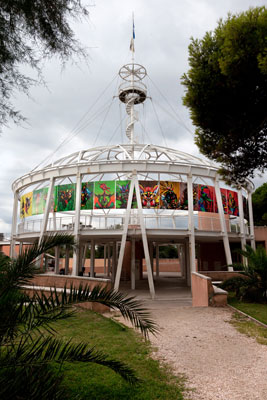
Twenty-four characters with a passionate visionariness, seem to come out of a tube of paint so dense their corporeity is, which is then shaped by digital technology not to allow any smears but to prefer a formal virtuosity that smells like plastic and resins. The images entitled Faces make up the large installation by Gaetano K. Bodanza for the event OPEN in Venice. A sort of giant carousel, which doesn’t turn on itself but makes the viewer turn along its circumference, suggesting them a frontal exchange of glances with these unusual characters, disturbing and burlesque at same time.
Seconda natura is the title of the work belonging to the new series of the Italian artist, recently presented at the Moretti & Moretti Gallery in Paris, where a futuristic setting, developed on three meters of length, gives birth to the characters of Faces. It’s a landscape crowded and teeming with shapes, gestures and looks, some of which we find again in the installation of Venice.
Out of the context of a crowd within which we must carefully look for and recognize them, here they stand out against backdrops of a saturated monochrome, as if it were a photo-card from an alien world.
From the crowd of hominids, insects, cartoon characters and small toys, Bodanza extrapolates the brightly colored portraits, that in his production go alongside the myths and icons of entertainment, advertising and art history, from Superman to Mickey Mouse, from the Nike of Samothrace to Marilyn, from Bambi to the Native Americans. Metabolizing Walt Disney, Hollywood and the entertainment world in general, as well as scientific research on genetics and ecology, Bodanza has always tightened a rope between true and fiction.
Now the artist on that rope comes up to a second nature and puts next to his truer than true works, obtained thanks to his great technical skill in both painting and fiberglass sculpture, a more intense dose of visionariness. Because people in Faces are no longer realistic, but look at us with piercing eyes and interact with us through gestures and expressions from which we can obtain a bizarre manual on human feelings.
Text by Sabrina Zannier
ITALY - ALICE OLIMPIA ATTANASIO
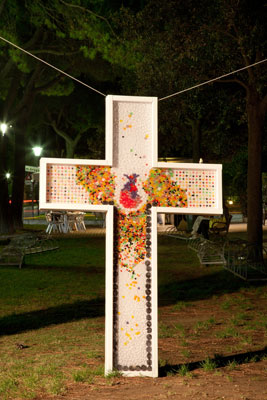
The artist Alice Olimpia Attanasio was born in Milan, in 1985. There she attended the European Institute of Design, taking her diploma in 2008. Right from the start she chose painting as the most important expression of her artistic activity. However, as time passed, she also began presenting installations, which became more and more fundamental for her. In 2009, Alice Olimpia Attanasio was invited to the Galleria d’Arte Blanchaert in Milan for a personal exhibition entitled Les jeux, les caprices. Her professional turning point came very quickly. The artist won the prestigious Arte Laguna Prize - Under 25 Section for the season 2009/2010, for her painting exhibition. This success gave her the attention she deserved. Recently, Alice Olimpia Attanasio held another personal exhibition in the Galleria d’Arte San Lorenzo in Milan. Both installations and paintings were presented in a project entitled Medication, which will be continued at this event in Venice. From an aesthetic point of view it must be said that the artist tends to prefer interaction, both through conceptual abstraction and by directly involving the spectator. The philosopher Derrida reminds us that for the ancient Greeks, taking a medicine means upsetting the body. Consequently, to enable our organism to be well, we nevertheless have to hurt it first. The creativeness of Alice Olimpia Attanasio therefore focuses on the aesthetic of medication. Oil painting on canvas and installations present scenes of a more sweetened therapy. Often people who are examined in the outpatients’ departments or are admitted to hospital are afraid of the doctors’ instruments. Alice Olimpia Attanasio shows that an intravenous drip can be set up with globules that are not so much sucking (blood) as suckable (sweets), while in her imagination the nurses and doctors have the appearance of an animal or an innocent child, with bottles for dissolving sugar pills and scissors for cutting cords made of pure liquorice. Sometimes it is the medication that plays just for the sake of playing, but without any aestheticism of manner! But the medicine is useful and we take it for a very precise reason, under conditions or terms that rarely change. Despite this, Alice Olimpia Attanasio ensures that we look after ourselves aesthetically by means of a placebo. Consequently her art medicine is to be taken for its own sake. Essentially, the placebo is at the most a game.
Gadamer thought that also art in the broad sense was produced just for its own sake, just like playing.
In the exhibition in Venice, Alice Olimpia Attanasio shows a caramel cross. It is two metres tall, with a surface of transparent resin. Inside it we can immediately see the sweets of the aesthetic placebo, which form a coloured mosaic, with an anatomical heart in the centre to remind us of the relationship between cure and psyche. More crosses with sweetened symbolism also appeared in the Medication exhibition in Milan, though they were smaller in size. In Christianity, the Cross is both a visually painful sign and a symbolically restful one (in the hope of resurrection). The artist declares she is an agnostic; in fact, this work has nothing to do with religion, it is only the symbol of a healing faith. Anyway, we know that Faith is professed only for its own sake. In this sense, even the Cross of Christianity could be perceived exactly as a work of art.
Text by Paolo Meneghetti
ITALY - ANNALÙ
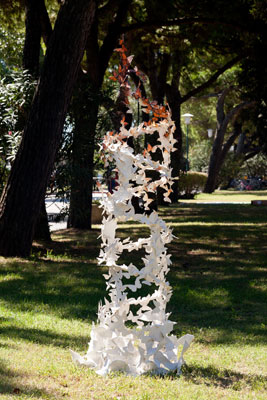
The metaphor of lightness is recurrent in Annalù’s sculpture. The white feathers that group together to form a swing hanging from a blue sky, the paper box that seems to be cut out of a child's drawing suspended among the branches of a tree, a castle of paper envelopes balanced on a tightrope, two stacked chairs flying, because one of the two is the white ghost of the other made of paper envelopes, are only some of the creations with which the artist gives shape to the ideas of weightlessness, of levitation in empty space. This metaphor of lightness provokes sculpture, denying one of its most characteristic, most traditional aspects, namely the bulky immobile mass, the gravity of material.
In recent years a new motif has appeared in Annalù’s work. In Altius and Fortius, two works of 2007, a whirlwind of laurel leaves is raised up and frozen in sculptural form: the regular design, with its abstract whirling leaves, is fixed in a double spiral motif, regular and abstract, which seems to challenge the passing of time with its immobility. A common natural phenomenon, made of nothing but leaves and air, results in a tangible monumental object which, when we observe its structure, reveals that it really does not have a well defined body, it has no other stable structure but the delicate, fleeting rubbing of one leaf against the other.
Twister, a new monument to lightness, uses butterflies instead of leaves, another subject from the world of nature that associates flight with lightness, on which Annalù gladly lingers. In Twister the swarm of butterflies, caught in a blast of wind, is frozen in an immobile spiral, sculpting in the air the imposing structure (about three metres tall) of a mysterious motionless flight: the dialogue between the static and the moving, between lightness and weight, truth and fable, is given a new expression.
The butterflies are light but, unlike the leaves, they are alive, not inert. Their swarm decomposes the regular patterns of the wind, trying to impose the patterns of a dance with a structure that is broken up and recomposed moment by moment, struggling with the gust of air.
Text by Gloria Vallese